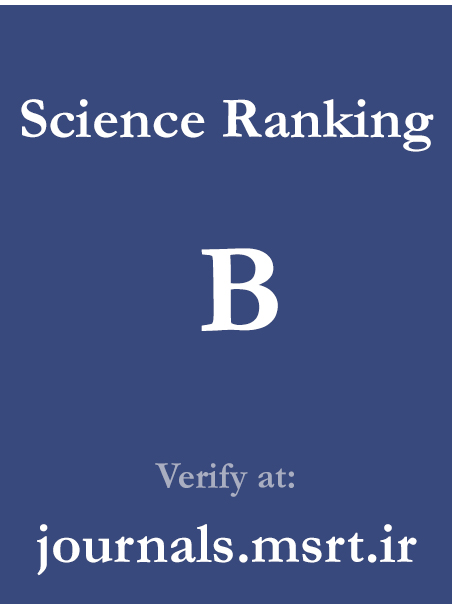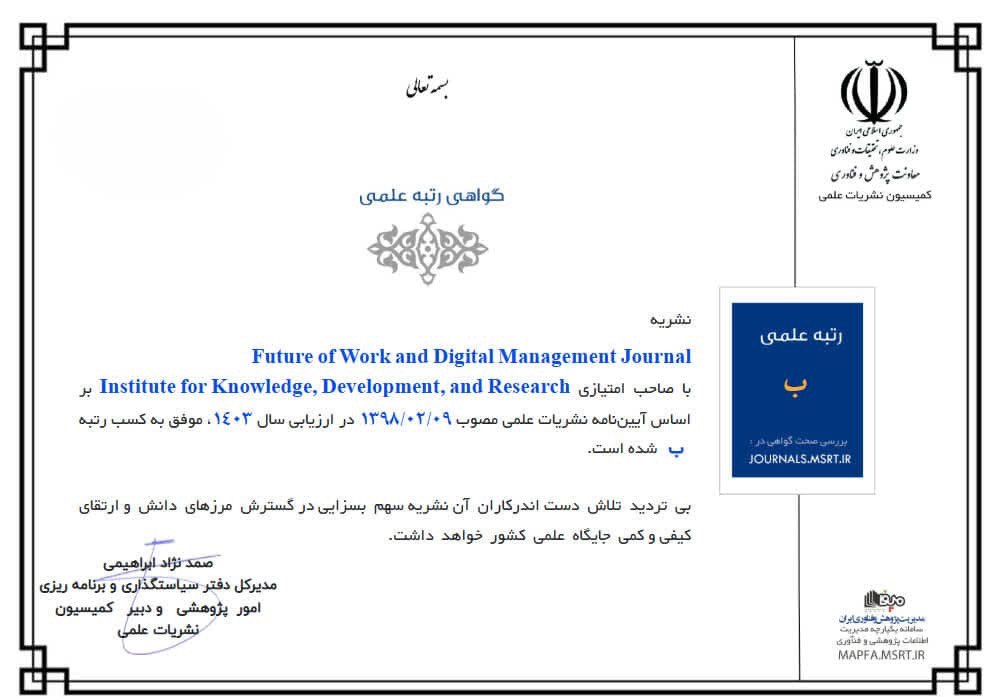An Effective Decision-Making Model in Social Security Branches (Case Study: Kerman Branches)
Keywords:
Effective decision-making, Social Security Organization, Kerman branches, exploratory factor analysis, thematic analysis, public administration, data-driven management, organizational participation, adaptabilityAbstract
This study was conducted with the aim of designing an effective decision-making model for the branches of the Social Security Organization in Kerman Province, intending to provide a localized framework for improving decision-making processes, enhancing organizational accountability, and increasing stakeholder satisfaction under the region’s complex conditions. A sequential mixed-methods approach (qualitative and quantitative) was employed. In the qualitative phase, thematic analysis of semi-structured interviews with 12 experts (branch and headquarters managers and specialists with a minimum of 10 years of experience) was carried out to identify the dimensions and components of effective decision-making. In the quantitative phase, exploratory factor analysis (EFA) was applied to a sample of 384 branch employees selected through multistage cluster sampling, using a questionnaire based on a five-point Likert scale. Thematic analysis of the interviews revealed that decision-making in the Kerman branches is often unsystematic, based on individual experience, and confronted with challenges such as lack of accurate data, insufficient transparency, and weak documentation practices. Key themes included the need for precise problem definition, strengthening of informational infrastructure, enhancement of employee participation, and continuous monitoring of decision outcomes. The exploratory factor analysis extracted eight key dimensions: strategic and policy-making, operational and executive, information and technology, data-driven analysis, organizational participation, organizational culture, evaluation and learning, and adaptability and innovation. These dimensions were validated using indicators such as financial sustainability rate with a factor loading of 0.82, clarity of SMART decision-making goals with a factor loading of 0.80, data accuracy rate with a factor loading of 0.80, and employee participation percentage with a factor loading of 0.79, altogether explaining 89.79% of the total variance.
Downloads
References
[1] S. Karimi, "Investigating Decision-Making Processes in Iran's Social Security Organization," Quarterly Journal of Public Administration, vol. 85, 2023.
[2] P. A. Sabatier, "Top-down and bottom-up approaches to implementation research," Journal of Public Policy, vol. 6, no. 1, pp. 21-48, 1986, doi: 10.1017/S0143814X00003846.
[3] C. Ansell and A. Gash, "Collaborative governance in theory and practice," Journal of Public Administration Research and Theory, vol. 18, no. 4, pp. 543-571, 2008, doi: 10.1093/jopart/mum032.
[4] B. W. Head and J. Alford, "Wicked problems: Implications for public policy and management," Administration & Society, vol. 47, no. 6, pp. 711-739, 2015, doi: 10.1177/0095399713481601.
[5] H. Burkner and J. Russell, "Public service transformations in developing countries," International Journal of Public Administration, vol. 72, 2023.
[6] B. Naeimaei and A. Shakouri, "Challenges of Implementing the Comprehensive Welfare and Social Security System in Iran in the 2010s," Social Welfare Journal, vol. 16, no. 63, pp. 9-52, 2016.
[7] G. Hofstede and M. Minkov, Culture and organizations: Impact of cultural characteristics on management. McGraw-Hill, 2022.
[8] M. Hill and J. Lynn, Systems theories in public policy. Routledge, 2022.
[9] A. Hassanpour, K. Emami, and M. Ezati, "The Impact of Social Security Revenue and Expenditure Shocks on Income Inequality in Iran," Quarterly Journal of Economic Modeling, vol. 46, no. 17, pp. 97-114, 2023.
[10] M. Sarfaraz Kakhekhi, M. Zabihi, S. Alvani, and M. Alborzi, "Presenting a Model for Evaluating the Effectiveness of Decisions in the Social Security Organization Using Mikhailov's Hierarchical Analysis Method," Strategic Studies of National Defense Management, vol. 6, no. 24, pp. 157-192, 2022.
[11] G. Aghaei, A. Habibzadeh, M. Rahimi, and A. Jafari, "Presenting an Organizational Leadership Model for Crisis Management in the Iranian Social Security Organization Based on Grounded Theory," Journal of Resource Management in Police, vol. 45, no. 2, pp. 67-79, 2024.
[12] A. Monavarian, H. Ehteshami Dizaji, and A. Peyvasteh, "Designing a Model for Virtual Training in Iran's Social Security Organization Based on Grounded Theory Analysis," Public Administration Journal, vol. 13, no. 3, pp. 533-560, 2021.
[13] G. Capano and F. Toth, "Designing policies that could work: Understanding the interaction between policy design spaces and organizational responses in public sector," Policy Sciences, vol. 57, pp. 53-82, 2024, doi: 10.1007/s11077-024-09521-0.
[14] M. Mohsen Beigi and M. Molla Mohammadi Ravari, "The Impact of Social Capital on Intrapreneurship with the Mediating Role of Organizational Commitment in Kerman's Social Security Healthcare Management," Social Security Journal, vol. 55, no. 2, pp. 175-204, 2020.
[15] D. P. Loucks, "Analyzing public policy decisions," in Water Resources Systems Planning and Management, 2022, pp. 3-25.
[16] R. Hosseini and R. Nazifi, "Analysis and Explanation of the Optimal Policy-Making Model for the Management System in Organizational Decision-Making of the Red Crescent Society," Journal of Public Administration, vol. 45, no. 2, pp. 90-108, 2023.
[17] C. Hood and P. Mair, New public management: Evidence-based approaches. Oxford University Press, 2020.
[18] L. A. Pal, Decision-making in complex organizations: Integrative approaches. Wiley, 2019.
[19] D. Valle-Cruz and R. Sandoval-Almazán, "Innovating and changing the policy-cycle: Policy-makers be prepared!," Government Information Quarterly, vol. 41, no. 1, p. 101898, 2024.
[20] S. P. Robbins and T. A. Judge, Organizational behavior. Pearson, 2023.
[21] P. Kumar and A. Gupta, "Reimagining public policy formulation and analysis: A comprehensive framework," 2023.
[22] D. Kaufmann, A. Kraay, and M. Mastruzzi, "The worldwide governance indicators: Methodology and analytical issues," in "World Bank Policy Research Working Paper No. 5430," World Bank, 2010.
[23] A. Soleimani, M. Esmaili Givi, and A. Pourezzat, "Envisioning the Future of Iran's Social Security Organization Through Scenario Planning," Defense Futures Research Journal, vol. 17, no. 2, pp. 93-117, 2020.
Downloads
Published
Submitted
Revised
Accepted
Issue
Section
License
Copyright (c) 2025 Zahra Negari (Author); Abbas Babaeinejad (Translator); Alireza Sanatkha, Soheila Shamsadini (Author)

This work is licensed under a Creative Commons Attribution-NonCommercial 4.0 International License.







